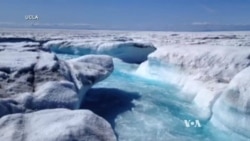If Greenland's ice and snow were to melt completely, global sea level would rise more than seven meters. Climate experts agree that frozen ground cover is melting at an accelerating pace, raising sea level.
Now a new study finds Greenland's vast network of little-understood rivers and streams is the major contributor moving that meltwater seaward.
UCLA geography professor Laurence Smith is lead author of the study. He says Greenland is not a vast plane of ice and snow but "a very wet icescape covered with branching streams, rivulets and even large flowing blue rivers" which rapidly remove meltwater from the ice sheet surface.
The meltwater is carried "by these highly organized stream systems over the ice and then into the ice through these sinkholes called moulins,” he says.
Those cracks penetrate deep into the interior of the ice sheet, carrying the meltwater into the ice, allowing it to escape into the downstream edge, and from there to flow to the ocean. So, Smith says, Greenland's ice sheet is "more like Swiss cheese" than "a featureless plane of ice."
Satellites and legwork
Smith and his graduate students are studying these features using satellites and down-to-earth legwork. In 2012, his team was in Greenland to map 523 waterways and to deploy a variety of high-tech tools. ["We used] a combination of satellite remote-sensing, using very high resolution military grade imaging systems from space, as well as intensive field work involving ice camps on top of the ice sheet, involving autonomous drifters and drones and other high tech approaches,” he says.
Writing in the Proceedings of the National Academy of Sciences, Smith says the meltwater loss from waterways is greater than loss from lakes and ice calving combined. Until now, those were thought to be the largest contributors to sea level rise.
"So what our work shows is a clear and definite connection between climatological melting on the top of the ice sheet and the downstream outflow of water to sea level rise and floods in the rivers moving over the Greenland coast."
Smith says his findings can better inform climate models that are predicting more intensive and extensive melting over Greenland in the future. That melting, he says, increases the likelihood of greater floods from surface waterways and their flow into the ocean.











